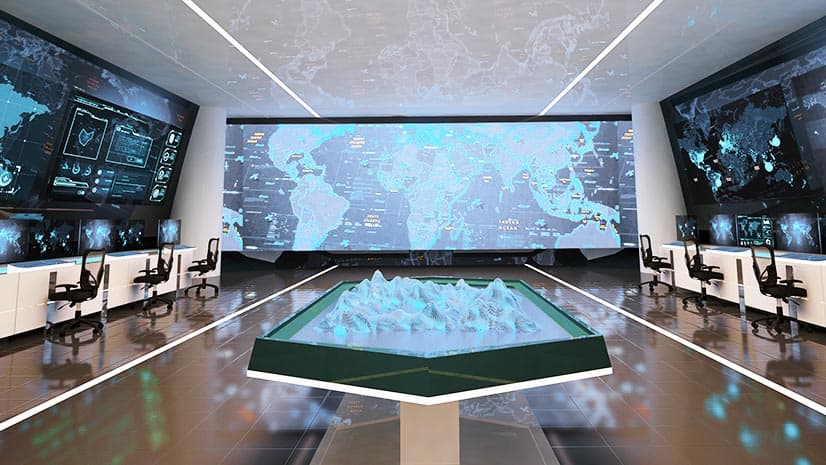Encouraging Your Company with Ironclad Corporate Security Actions
Wiki Article
From Cybersecurity to Physical Steps: Reinforcing Business Security in a Transforming Globe
By integrating the staminas of both cybersecurity and physical safety, companies can develop a thorough defense strategy that deals with the diverse variety of hazards they encounter. In this discussion, we will certainly check out the changing threat landscape, the requirement to incorporate cybersecurity and physical safety and security, the implementation of multi-factor verification procedures, the importance of worker awareness and training, and the adaptation of safety procedures for remote workforces. By examining these key areas, we will acquire useful understandings into how organizations can strengthen their company security in an ever-changing globe.Comprehending the Altering Hazard Landscape
The advancing nature of the modern world requires an extensive understanding of the changing threat landscape for reliable corporate protection. It is vital for organizations to remain informed and adapt their security determines to resolve these evolving risks.One secret aspect of understanding the transforming threat landscape is identifying the different types of risks that organizations deal with. In addition, physical hazards such as burglary, criminal damage, and company espionage stay widespread worries for organizations.
Surveillance and assessing the threat landscape is essential in order to determine potential risks and vulnerabilities. This involves staying upgraded on the current cybersecurity fads, analyzing threat knowledge reports, and conducting normal risk assessments. By recognizing the altering risk landscape, companies can proactively carry out suitable security measures to minimize dangers and protect their assets, credibility, and stakeholders.
Integrating Cybersecurity and Physical Safety And Security
Incorporating cybersecurity and physical safety is crucial for extensive business security in today's electronic and interconnected landscape. As organizations progressively rely on modern technology and interconnected systems, the limits between physical and cyber dangers are becoming obscured. To effectively guard against these dangers, a holistic technique that combines both cybersecurity and physical safety actions is vital.Cybersecurity concentrates on safeguarding electronic assets, such as systems, information, and networks, from unauthorized gain access to, interruption, and burglary. Physical security, on the other hand, includes actions to secure physical possessions, individuals, and centers from susceptabilities and hazards. By integrating these two domains, organizations can attend to vulnerabilities and hazards from both physical and digital angles, thus improving their total security posture.
The integration of these two self-controls permits a much more thorough understanding of protection risks and enables a unified response to events. Physical accessibility controls can be boosted by incorporating them with cybersecurity methods, such as two-factor verification or biometric recognition. Likewise, cybersecurity procedures can be matched by physical safety procedures, such as monitoring cams, alarm systems, and safe gain access to points.

Implementing Multi-Factor Authentication Actions
As organizations significantly prioritize extensive protection measures, one efficient strategy is the implementation of multi-factor authentication procedures. Multi-factor verification (MFA) is a safety approach that requires users to supply numerous kinds of recognition to access a system or application. This approach includes an additional layer of defense by combining something the customer knows, such as a password, with something they have, like a protection or a finger print token.By executing MFA, organizations can substantially boost their security posture - corporate security. Conventional password-based authentication has its restrictions, as passwords can be conveniently endangered or neglected. MFA minimizes these risks by adding an additional authentication factor, making it harder for unauthorized individuals to access to sensitive information
There are several types of multi-factor authentication methods readily available, consisting of biometric verification, SMS-based confirmation codes, and hardware tokens. Organizations need to assess their details needs and pick the most suitable MFA solution for their needs.
Nevertheless, the application of MFA should be very carefully prepared and carried out. It is vital to strike a balance between security and use to stop individual disappointment and resistance. Organizations should additionally think about check out this site prospective compatibility concerns and supply sufficient training and support to make certain a smooth shift.
Enhancing Employee Understanding and Training
To enhance business safety, organizations must focus on enhancing staff member understanding and training. In today's rapidly progressing risk landscape, staff members play a critical function in guarding an organization's delicate info and properties. Sadly, many safety violations happen as a result of human error or absence of understanding. Organizations require to spend in comprehensive training programs to inform their staff members about prospective dangers and the ideal practices for reducing them.Efficient staff member awareness and training programs should cover a large range of subjects, including information security, phishing attacks, social design, password health, and physical security procedures. These programs must be customized to the details demands and duties of various employee roles within the organization. Regular training simulations, workshops, and sessions can assist staff members create the essential skills and knowledge to identify and respond to security risks successfully.
In addition, companies must urge a culture of security awareness and offer continuous updates and pointers to maintain workers informed concerning the most up to date risks and mitigation techniques. This can be done through interior interaction networks, such as newsletters, intranet sites, and email campaigns. By fostering a security-conscious labor force, organizations can substantially minimize the likelihood of security cases and secure their valuable possessions from unapproved gain access to or concession.

Adapting Safety And Security Procedures for Remote Workforce
Adjusting company security steps to fit a remote labor force is crucial in guaranteeing the security of sensitive info and properties (corporate security). With the raising fad of remote work, organizations must execute suitable safety procedures to minimize the threats related to this brand-new means of functioningOne crucial aspect of adjusting security actions for remote job is developing safe and secure interaction networks. Encrypted site link messaging systems and online personal networks (VPNs) can help safeguard sensitive information and prevent unapproved access. In addition, organizations should enforce the usage of solid passwords and multi-factor verification to improve the safety and security of remote access.
Another vital factor to consider is the execution of safe remote gain access to solutions. This involves giving workers with protected accessibility to business resources and data via online desktop computer framework (VDI), remote desktop computer methods (RDP), or cloud-based remedies. These innovations ensure that sensitive info remains secured while making it possible for staff members to do their roles properly.

Finally, thorough security awareness training is important for remote staff members. Educating sessions should cover best methods for safely accessing and taking care of delicate details, identifying and reporting phishing attempts, and maintaining the overall cybersecurity hygiene.
Conclusion
Finally, as the risk landscape continues to evolve, it is essential for organizations to enhance their safety determines both in the cyber and physical domain names. Integrating cybersecurity and physical safety, carrying out multi-factor verification procedures, and improving worker awareness and training are vital steps towards achieving durable company protection. Furthermore, adapting safety and security steps to accommodate remote labor forces is imperative in today's changing globe. By carrying out these steps, organizations can mitigate threats and secure their important assets from potential hazards.In this discussion, we will check out the altering risk landscape, the need to incorporate cybersecurity and physical security, the execution of multi-factor authentication actions, the value of worker understanding and training, and the adaptation of security procedures for remote workforces. Cybersecurity procedures can be enhanced by physical safety and security actions, such as monitoring electronic cameras, alarms, and safe access points.
As companies significantly prioritize detailed security steps, one reliable approach is the application of multi-factor verification measures.In final thought, as the danger landscape proceeds to evolve, it is vital for companies to he said strengthen their safety and security determines both in the cyber and physical domain names. Incorporating cybersecurity and physical security, executing multi-factor verification actions, and boosting employee awareness and training are vital actions in the direction of attaining durable corporate security.
Report this wiki page